Menus
- One step ahead
- 4 cylinders in V at 65 °, 1,099 cm3, 217 hp and 125 Nm, 202 kg, semi-active suspensions, aerodynamic fairing, 23,999 euros
- Discovery
- Standard RSV4 version
- In the saddle
- On track
- Video test of the RSV4
- Conclusion
One step ahead
4 cylinders in V at 65 °, 1,099 cm3, 217 hp and 125 Nm, 202 kg, semi-active suspensions, aerodynamic fairing, 23,999 euros
With 54 victories in the world championship, Aprilia imposes its mastery of racing machines. One of them enjoys an unparalleled aura, ahead of the notoriety of its brand by its surname: the RSV4….
A little genealogy. The Noale firm designed the RSV 1000 in 1998. Powered by a Rotax twin-cylinder when it was created, the 60 ° V-shaped unit then developed 128 hp at 9,250 rpm and 103 Nm of torque at 8,000 revolutions / min. The machine adopts in 2009 a completely new V4 mechanics, delivering 180 hp at 12,500 rpm and 11.5 da.Nm at 10,000 rpm under control of an electronics (APRC) derived from the race. The sportswoman will thus win 7 trophies in 6 years (pilot and / or manufacturer), becoming THE undisputed star of the Superbike championship. The RSV4 continued to benefit from major mechanical developments in 2015 to pass the 200 hp bar: 201 nags at 13,000 revolutions and 11.5 da.Nm at 10,500 rpm. Two years later, an RF version receives an electronic update to boost its audience and reliability. To face the race for the stars and fight with competing rockets, Aprilia strengthens its interceptor in 2019. Its engine increases to 1,077 cm3 and its power to 217 horsepower. And to make the best use of this dynamic, the sports car receives side fins.
The natural evolution pushes the Italian sports car to improve again in 2021. On the program, a welcome facelift for a spectacular aesthetic, an increased displacement to outsmart Euro5, an optimized cycle part and high-end electronic suspensions for the Factory model . Importantly, the standard version receives the same engine and the same electronics. Only its cycle part differs. And for the occasion, she loses her number. Farewell the RSV4 1100 for a simpler RSV4, or even an RSV4 Factory, our test model in Italy.
 Aprilia RSV4 Factory 2021 test
Aprilia RSV4 Factory 2021 test
It is on the Marco Simoncelli circuit in Misano that we thus contract space and time on the handlebars of theAprilia RSV4 in version Factory.
Discovery
With its new aerodynamic downforce and increased displacement, the 2019 RSV4 had kept its place as a high performance ballerina. But we were impatient to see its aesthetic reworked, in line with the RS 660. It’s done in 2021! Modernized, the Italian sportswoman refines her features without losing any of her character. Hyper-compact, she keeps her mannequin dress, mixing taut curves and protruding edges. The sculpted and complex curves always seduce with their overall elegance and finesse. But the shapes are more fluid and the whole becomes more homogeneous. More elegant, its sharp front face receives a new triple LED optic more tapered which also integrates the cornering light function. Note the luminous surround of the headlights rising in two aerodynamic streaks on the fork crown…. An ultra-contemporary light signature. A twilight sensor enables automatic switching on of the dipped beam headlights. The programmed-off direction indicators flash even in the event of emergency braking (the function is deactivated for use on the circuit).
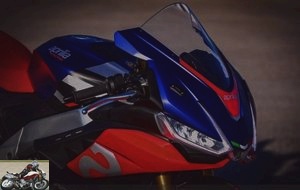 The lines of the RSV4 have been reworked in line with those of the RS 660
The lines of the RSV4 have been reworked in line with those of the RS 660
Under these lights, the RSV4 now fully integrates its large aerodynamic carbon fins. Wider, at the ends in mini-winglets, these appendages contrast with the tapered style of the machine. Their vermilion color contrasts effectively with GP’s historic RS 250 type purple livery. They undoubtedly give the RSV4 a very strong competitive lineage. Almost a prototype. These elements channel the air pressure downward, generating 8 kilos of downforce at 300 km / h. This improves stability at high speeds and during sudden decelerations..
The set combines more finely with the fairings. The latter noticeably develop their surface, rationalize their design. Joined (roughly….) To the frame, they optimize air flow, heat extraction and deflection. Lower down, the shoe simplifies and fluidifies its shapes, giving the machine a more subtle finish. These design evolutions allow a very reduced coefficient of aerodynamic resistance improving high speed performance and efficiency. Likewise, the rider’s protection increases (11%), further isolating the shoulders and head.
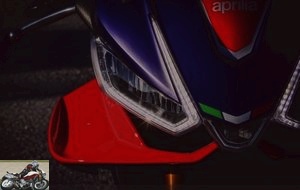 The aerodynamics of the fairing have been significantly revised
The aerodynamics of the fairing have been significantly revised
Higher, the tank of 17.9 liters (-0.6 L) also evolves, losing 34 mm in width. An important element of ergonomics on the track, its new volumes with less marked curves will therefore have to be studied in dynamics. Most of the fuel is housed under the saddle, optimizing the balance of the bike. It also reduces the driving differences between full and empty tank..
It is supported by a redesigned pilot seat, topped by the removable hood with profiled wings of the passenger seat. Minimalist, the rear buckle receives a more elegant trim and supports slender, easily removable passenger footrests.
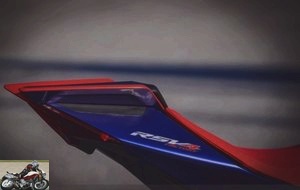 The rear buckle cover is more elegant
The rear buckle cover is more elegant
Its stylish dress always contrasts with the metal parts of the machine, especially those of the imposing double beam aluminum frame. Its polishing contrasts with the reinforcements and plates with surfaces left rough. The cycle part barely changes its dimensions. The caster angle increases a tiny bit by 0.1 ° or 24.6 °. The offset of the new triple trees is reduced by 2 mm in order to bring the front axle closer to the driver, to increase the load on the front wheel (and therefore stability) without reducing agility.
The wheelbase is reduced by 3 units, or 1,435.8 mm. But that will be clearly variable … Because a true descendant of superbike machines, the RSV4-1100 Factory and RR are still the only series machines to offer extensive customization of the chassis: position of the engine in the frame, angle of the steering column. steering, ground clearance and swingarm pivot height adjustment….! The latter uses the same construction technology as the frame, but its construction now has only 3 welded elements instead of 7. Reducing the unsprung masses by 600 grams, it is above all its transverse rigidity at the level of the wheel axle which increases by 30%. In addition, the wheel axle position adjustment window is remarkably extended for a greater range of rear wheel positioning..
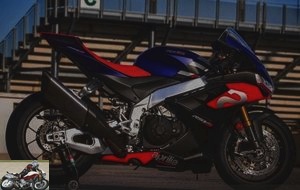 The wheelbase is slightly reduced and the unsprung weight is reduced
The wheelbase is slightly reduced and the unsprung weight is reduced
What to take full advantage of the mythical V4 with a volcanic character. To switch to Euro5 without reducing its qualities, the displacement of the four-cylinder V at 65 °, in fact goes from 1.078 cm3 to 1.099 cm3 by increasing the stroke from 52.3 to 53.32 mm. The compression ratio is 13.6: 1. Its two camshafts attack 4 titanium valves per cylinder. Thus, no less than 217 hp now come out of the block at 13,000 rpm (- 200). The torque increases over the entire curve and reaches a maximum of 125 Nm (+3) at a lower speed of 500 rpm, i.e. 11,000 rpm. Values that will optimize mechanical availability. Remember that the camshafts are forged, ditto for the crankshaft. Finally, the sprockets of the cassette box now receive a DLC (Diamond Like Carbon) treatment. Of course the clutch is, as for a long time, anti-dribble. The V4 now blows in a new Akrapovic titanium silencer as standard.
With this added character, the mechanics also take care of their chips. Because the advanced electronics APRC (Aprilia Performance Ride Control) is another of the remarkable qualities of the RSV4. A new Magneti Marelli ECU 11MP control unit allows connection to a greater number of elements thanks to a computing capacity four times faster than the previous one.
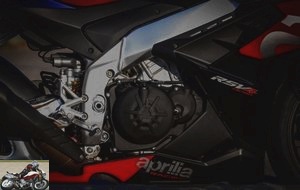 The 1.099 cc V4 delivers 217 hp and 125 Nm
The 1.099 cc V4 delivers 217 hp and 125 Nm
In particular, she drives 6 driving modes, 3 for the road (Street, Sport, User) and 3 for the circuit. The latter set offers the Race profile, i.e. pre-programming by Aprilia and two customizable User modes. The choice of Ride by Wire maps is also done while riding.
This possibility of modifying in an instant and at any time the most important electronic settings remains the great strength of Aprilia, translating its experience in competition. The best use of the APRC system is thus thus made. This renews its components and brings in new ones. Optimized in their operation, we find traction control (ATC), anti-wheeling management (AWC), Launch Control (ALC) optimizing starts and Quickshifter (AQS) now up AND down gear. The 2021 vintage is also equipped with a cruise control (ACC) to reach your circuit and a Pit Limiter (APL) setting your speed in the pits. One will prevent you from losing points on your license, the other in the championship ….
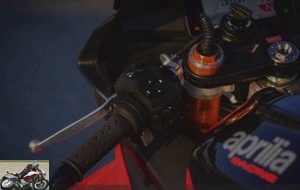 The APRC electronic package is as complete as ever
The APRC electronic package is as complete as ever
Let us specify the use of the most important of these aids. Directly configurable in race / road, ATC, Aprilia Traction Control, always modulates on 8 values without releasing the throttle thanks to the mini-paddles + and -. The same goes for the AWC: Aprilia Wheelie Control, thanks to a new push button on the left stalk. If the front wheel is lifted, the electronics intervene on the ignition advance and the injection butterflies. Adjustable on 3 levels, it has new, more precise and progressive laws of use, thanks to the repositioning of the inertial platform.
The latter is also essential when braking, especially on the angle. The ABS uses the miniaturized Bosch 9.1 MP device, widely used by the competition as well. Hyper compact and light, it now makes it possible to optimize braking in bends thanks to an Aprilia specific algorithm, which constantly controls lateral acceleration, the pressure exerted on the front brake lever, the roll, pitch and pitch angles. lace. In the event of inconsistency, it modulates the pressure of the calipers to ensure the best balance between deceleration and stability. The system renews the RLM (Rear Liftup Mitigation) limiting the lifting of the rear axle during the most important decelerations. Multifunctional, this ABS is adjustable on 3 levels Track, Sport and Rain and can be disconnected (but reactivates when restarting …. Euro4 requires). On Track, the RLM and the ABS on the angle are deactivated, for the purists. Sport maintains progressive rear lift above 140 km / h and full below 80 km / h.
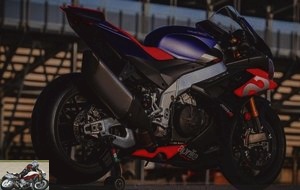 Aprilia RSV4 Factory
Aprilia RSV4 Factory
Since 2020, the RSV4 Factory has been equipped with electronically controlled suspensions. Its high-end Ohlins components are therefore under the semi-active Smart EC 2.0 control. The fully adjustable 43mm NIX fork is sealed with pressurized cartridges reducing oil volume and therefore weight. Its stroke is increased by 5 mm (125 mm) and is added the control of a Swedish steering cylinder also configurable. Upper yoke and fork base are aluminum cut in the mass. Also multi-adjustable, the TTX 36 piggy back shock absorber is mounted on rods and slides over 115 mm.
The semi-active Smart EC 2.0 technology allows a personalized calibration of the damping according to two operating modes: semi-active mode and manual mode, both adjustable on the handlebars via the OBTi (Objective Based Tuning Interface), visible on the dashboard. 3 profiles adjust the settings for each of the two modes. In semi-active: A1, A2 and A3. The former is suitable for the use of slick tires and well-coated circuits; the second is suitable for mixed tires and circuits with an uneven surface; the third is intended for the road thanks to a freer hydraulics and better absorbing imperfections. In manual mode, the 3 profiles (M1, M2 and M3) correspond to predefined calibrations and without semi-active assistance, as would mechanical suspensions. Whether in semi-active or manual mode, the user always has the possibility to fine-tune the suspension calibration according to his preferences and driving style. The Ohlins steering damper is now also controlled and adjustable by the same system.
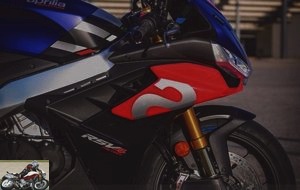 The Factory opts for Цhlins Smart EC 2.0 semi-active suspensions
The Factory opts for Цhlins Smart EC 2.0 semi-active suspensions
Mounted on 17-inch forged aluminum rims, the RSV4-1100 Factory is fitted with Brembo Stylema monobloc front calipers, radial mounted and 4 pistons of 30 mm. Equipped with new brake pads, they attack 330 mm lightweight stainless steel floating discs. All controlled by a radial master cylinder of 18 mm and reinforced braided brake hoses. The opposing retarder, a Brembo 2-piston floating caliper, grips a 220mm slab. The assembly is monitored by a Bosch 9.1 MP ABS adjustable to 3 values, itself controlled by the inertial unit and equipped with RLM (Rear wheel Lift-up Mitigation). Each of the three ABS Cornering maps can be combined with any of the three engine maps (Sport, Track, Race).
To stick to the bitumen, Pirelli SuperBike SC1 in 120/70 and 200/55 fit the feet of the Italian (alternative in 190/50 or 190/55). And at the end of winter, the envelopes are preparing for exercise under heated blankets.
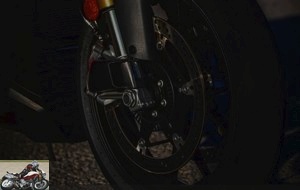 The 17 "rims are fitted with Pirelli Superbike SC1
The 17 "rims are fitted with Pirelli Superbike SC1
Finally, the RSV4 Factory 2021 admits 202 kg ready to race, or 3 more than the 2019 version, driven suspensions oblige. Particularly attractive, the RSV4 1100 Factory is remarkably finished and equipped. The design of the elements, the quality of the components and the coating of the majority of the metal surfaces are without reproach. The surfaces of the cylinder blocks and center crankcases always show a rough finish, always giving the machine a racing feel. However, I regret that the aesthetic engine mounts are now unfortunately hidden by the new fairing whose adjustment to the frame can be improved..
Standard RSV4 version
The standard model is fitted with Sachs suspensions. The 43 mm inverted fork is adjustable in any direction and its base is forged in aluminum. A steering cylinder of the same origin also limits unwanted movements of the front axle. At the rear, the shock absorber can also be adjusted in terms of preload, compression, rebound and center distance (wheelbase). Its rims are in die-cast aluminum, but the braking uses the same elements as those of the Factory. The APRC electronics are identical and the model also has the up and down Quickshifter.
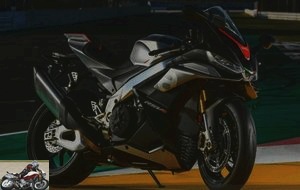 There is also a standard version with classic suspensions
There is also a standard version with classic suspensions
In the saddle
Compact, narrow, the Aprilia RSV4 is also more accessible. 6 mm. Yes, the demand for your handlebars begins with access to your backbone. The Diva adjusts its saddle to 845 mm. Enough to humble any pretending a bit presumptuous. Remarkably designed, its appreciable length and its sloping sides favor a sporty gesture. My eighty-four meter allows me to keep just half of the boot soles on the asphalt. I love this subtle exclusivity from the seat, noticeably tilted, projecting its pilot forward.
 The saddle remains quite high at 845 mm
The saddle remains quite high at 845 mm
Narrower by 34 mm, the tank loses its characteristic shoulders, so appreciable under braking to wedge its legs. Despite 9 mm lower footrests, these rear controls generate a sporty flexion of the legs, quite logical. Despite this, Aprilia announces an optimized angle of 1.5 °. With this ergonomics, the superbike experience continues, dropping bust and glove towards the straps. Their limited inclination and a fairly wide opening induce an ideal grip.
The cockpit also lets you spend a few fractions of time, combining a 5-inch TFT screen, fork cap with electronic perfusion and thick controls to steer the interceptor. And there is something to do to choose its modes, adjust the APRC assistance already listed, its engine brake…. etc. Topped with a large shiftlight, the screen automatically switches to day or night mode and has two different displays, road or circuit. On the latter, the provision of information gives pride of place to sport. It thus groups together, under the highly readable bar-graph tachometer, the chrono or speed display, the gear engaged and the speed limit chosen for the pitlane (or cruise control). Also, the APRC information is judiciously grouped in the lower left corner, with the engine map selected, the level of ATC, ABS, AWC and ALC desired (anti-slip, ABS, anti-wheeling and stop-start) . A menu also allows you to enter in more detail if you wish..
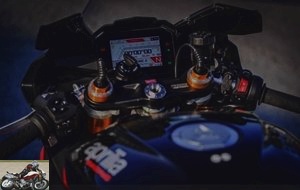 The cockpit of the RSV4 Factory
The cockpit of the RSV4 Factory
We appreciate the famous mini-paddles + and – to modulate always directly and without closing the throttle or disengaging, the traction control (ATC). The wheelie adjusts to the cruise control rocker. Clear, well organized, the screen also allows you to configure the chip suspensions. Semi-active A1 mode engaged, the machine is in optimal configuration to feel the track.
Finally, Aprilia’s multimedia platform allows you to connect your smartphone to the motorcycle. It includes both the infotainment system to manage the voice assistant, phone calls and music via the intuitive controls of the handlebars, as well as the navigation function, with which it is possible, once the destination of the trip set on the smartphone, to display the instructions directly on the dashboard. The Aprilia MIA application also makes it possible to record the routes taken and analyze the data acquired directly on the application thanks to the geo-referenced telemetry function.
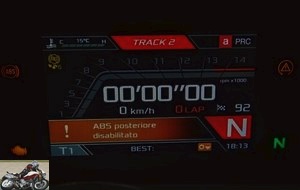 The TFT counter can also be connected to the smartphone via the MIA application
The TFT counter can also be connected to the smartphone via the MIA application
Still a bit unfortunate, the basic and cable clutch control is not adjustable in spacing! A shame for this type of ultimate flagship. Fortunately, the milled aluminum brake lever is modular and its radial master cylinder.
On track
The contrasting course of Misano, 4,226 m and 16 turns (6 to the left, 10 to the right) including a fast triple right, also has three straight lines. Its rapid development and strong decelerations make the Marco Simoncelli circuit an ideal test location for our Factory.
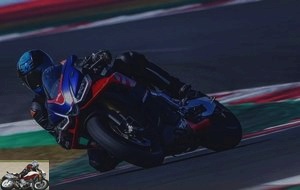 The Misano World Circuit Marco Simoncelli is the perfect place to put the Factory to the test
The Misano World Circuit Marco Simoncelli is the perfect place to put the Factory to the test
Inimitable, the vocals of the Aprilia V4 resonate almost unfiltered, faithfully trumpeted by the streamlined exhaust. The Italian barked viciously at the gas, eager to shorten the space. The access ramp winds before throwing the winged missile onto the runway. A fraction of a second is enough to once again reveal the dynamic potential of Aprilia. The front axle rises, saluting as a tribute the rapid route of an Ave Marco, Volveri Te Salutant. Rumbling, the superbike is already spinning towards Rio, a quick sequence of a double right. We throw ourselves in lightly to keep the angle between the two curves. Perfectly stable, the machine adjusts to the trajectory with a glance. We hardly seem to overlap it as its ergonomics leave it comfortable on board. Without any downtime, we aimed to the left at turn 6 commanding the first straight line. Under ATC control, the rear casing drifts, undermined by 125 Nm of torque, which is always better transmitted to the ground by an optimized swingarm. Hyper rigid, the RSV4 is lightened and slightly waved its fork, usefully braked by its steering cylinder. From the tip of the boot, we pass the 3, the 4. And Quercia already requires to take the brakes. Powerful, but remarkably flexible, the strength of the Brembo Stylemas is at the level of that of the V4. The constant quality of the decelerations is remarkable, can be further amplified by the optional carbon scoops (276 €!) Placed on the calipers of our testing machines. Under their bite, the steering gear settles down, the rear rises and gently moves the machine. One can imagine the frenzy of calculation of the whole APRC system to regulate the movement. A new parameter is added to it, that of amortization. On these first evolutions, it seems too flexible to me, generating a certain blur before putting it on the corner. No time to think more about it. That long, tight curve to the left makes me appreciate once again how easy it is to turn the RSV4. Almost an extension of its pilot, Noale’s creature faithfully follows your instructions, even correcting your approximations a little ….
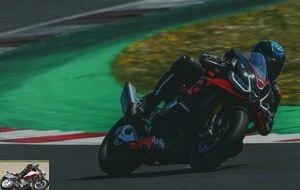 From the first meters, the V4 reminds us of all its qualities
From the first meters, the V4 reminds us of all its qualities
Stretching and streaking 9 and 10 require careful trajectory, speed and precision to ensure an effective recovery. Everything your mount can handle perfectly. I like its fine-grained throttle grip, providing outstanding control over go-arounds. We quickly understand that to fight with the RSV4 would be a deplorable goujaterie. The beauty must be handled with thoughtfulness to appreciate its effectiveness. Handled with mastery, hypersport just got easier. Hyper demonstrative, Aprilia accompanies your evolutions with an inimitable soundtrack, hoarse, ample and frantic. Exhaust and airbox combine for an unparalleled vivacious grondato tremolo duet. This sound signature is a permanent enchantment which clearly contributes to the enjoyment.
The ever-increasing driving force will catapult you over the corner to the rest of the program. We are then almost at the crossroads of the torque and power curves, between 8 and 9,000 rpm. At this point RSV4 unpacks and orbits the crew. Noale’s sports car remains a living, but healthy motorcycle. She communicates her controlled exuberance to her pilot. Thus, the front axle moves under the load of the engine, but the steering damper is on standby. At high speed, the heading is flawless and the protection very correct. We can only praise the aerodynamic downforce generated by the front fin of the transalpine interceptor.
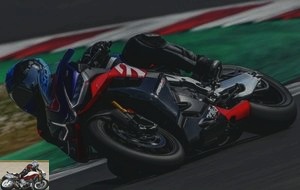 It is between 8 and 9000 revs that the engine responds most vigorously
It is between 8 and 9000 revs that the engine responds most vigorously
For the moment, we are running towards Curvone, the beginning of a waltz bottom of four, but at three times between curves 11, 12 and 13. Time to enter the gears that swallow the anti-dribble clutch and the we pass the hairpin 14. Barely enough time to straighten up to melt on the penultimate bend and prepare the final left, Misano, we often get there too hard. However, the latter controls the straight line of the pits. A little application limits movement and helps fine-tune the angle while holding the brakes. Before we put our Factory on the line. This rectilinear end scrolls briskly. Barely enough time to pass the four that we grab the lever with one finger to set the brakes.
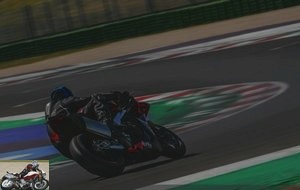 The RSV4 is well channeled by the multitude of assistance
The RSV4 is well channeled by the multitude of assistance
A quick bump then allows us to judge the unusual agility of our two-wheeled chrono. Master of time, he is also of balance. The neutrality of the front axle, the obviousness of its placement and the weakest inertia make the RSV4 dance in the sequences. Its fairly high center of gravity and a geometry tilted to the front make it a lively and demonstrative machine. Added to the increased rigidity of its swingarm is the lightness of its forged rims. Their reduced inertia clearly contributes to this feeling of ease in tilting the machine from one angle to another. Turns 1 and 2 are erased and we just as naturally forget the next to go around the Adriatic merry-go-round again.
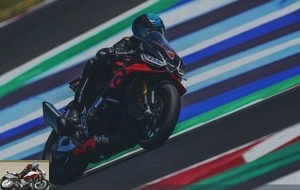 Noale’s hypersportive is always so fun to take to the circuit
Noale’s hypersportive is always so fun to take to the circuit
During the last session, I switch the suspensions to manual M1 mode, thus freezing the setting as on conventional elements. My feelings on all the driving phases are better. The machine moves less on the raises and always remains more neutral in the curve. It is especially under braking that handling improves, reducing the blur of direction previously generated by continuous adjustment. I prefer this less filtered feedback allowing me to better appreciate the evolutions of the RSV4. So more homogeneous, in my opinion, the Aprilia allows me to ride more calmly. However, the Smart EC 2.0 technology is remarkable and would save the seasoned rider almost a second per lap. I have no doubt that, taken with talent and conviction, the cycle part will then be more efficient. With an average level, Noale’s superbike may seem less brilliant. The advantage is that everyone can find their marks there.
Video test of the RSV4
Conclusion
Ever more stylish, a true offshoot of competition, the Aprilia RSV4 is a hyper-sport apart. Its advanced complete electronics and the sensitive and specific adjustments of its cycle part make it an unparalleled racing machine. Always more efficient, the Italian knows how to stay alive, always emphasizing the exuberance of her V4. Precise, lively, she communicates her very transalpine life to her pilot. This one will find with its controlled suspensions a great possibility of behavior and adjustments. We regret that we were unable to try the standard version on the track. The latter charges € 18,399 and the Factory version € 23,999. A real price difference justified by state-of-the-art damping and high-end rims. Not sure that, for most of us, the standard version is not more than enough.
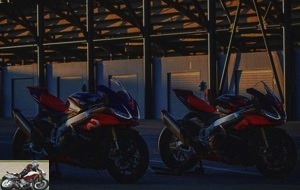 The two colors of the Aprilia RSV4 Factory
The two colors of the Aprilia RSV4 Factory
Opponent of the same nationality, the thundering Ducati Panigale V4 R claims at least € 23,590 to take up residence in your garage. Across the Rhine, the BMW S1000RR is priced at € 19,200 base, but € 22,730 to compete with the more efficient Aprilia. At Suzuki, the GSX-R 1000 R is available against 19,999. And at Yamaha, the R1 and its four-cylinder crossplane are at 19,299 € and the R1 M version at 25,999 €.
Financially accessible and formidable dynamically, the Aprilia RSV4 2021 have been able to progress on their weak point and sublimate their strengths. Charming superbike, the RSV4 brings you its subtle control to give you, at all times, one step ahead.
Strong points
- Elegant and strong aesthetic
- Mechanical personality
- Precision and liveliness of the cycle part
- General ergonomics
- Quality of suspensions
- Efficient electronic assistance
- Flawless brakes and ABS
- Precise up and down quickshifter
- Addictive sound
- Quality of finishes
- Overall dynamic efficiency
- Pleasant instrumentation
Weak points
- Less marked tank shoulders
- Semi-active damping feeling
- Basic clutch lever
- Adjusting the sides to the frame
Aprilia RSV4 Factory technical sheet
Test conditions
- Itinerary: Misano Marco Simoncelli circuit
- Weather forecast: sunny, 10 to 18 ° C
- Problem encountered: ras
Test equipment
- Scorpion Exo R1 Helmet
- Vanucci Speed Profi IV Gloves
- Dainese Laguna Seca suit
- Dainese Torque D1 Boots
Related articles
-
Aprilia Tuono V4 1100 Factory motorcycle test
The veloce vita in a bestial roadster, really bestial V4 at 65 ° of 1.077 cm3, 175 hp and 121 Nm, controlled suspensions Ohlins SmartEC 2.0, APRC, 17,999…
-
Aprilia RSV4 1100 Factory motorcycle test
Veramente sensazionale V4 at 65 ° of 1.078 cm3, 217 hp and 122 Nm, 199 kg full made, 22,999 euros There are machines whose surname is almost better known…
-
Aprilia Tuono V4 1100 Factory test
The Tuono unveils the sporty Aprilia to become a chic and shocking roadster Factory with thrills A shock variation derived from the hyper sporty RSV,…
-
180 horses … Road, race or wild horses The RSV series appeared in 1999. Aprilia, a Piaggio group, took care of the cycle part, but the engine was then…
-
Aprilia RSV4 RR & RF Factory test
Absolut Diva Ultimate evolution of hypersport from Noale’s firm A benchmark in the Superbike Championship, the Aprilia RSV4 boasts a unique engine and a…
-
Superbike One second better in the lap! This is the promise of Aprilia evoking its new RSV4 RR and RF, compared to their predecessors. And knowing the…
-
Ducati Streetfighter V4 S motorcycle test
Super power inside 4 cylinders in V at 90 ° Desmosedici, 1,103cm3, 208 hp at 12,750 rpm, 178 kg dry, 22,990 euros Everyone knows the Mostro, which has…
-
Aprilia RS 660 motorcycle test
Root of RSV4 = RS 660 Parallel twin, 659 cm3, 100 hp, 67 Nm, 183 kg, A2 version, APRC pack, 11,050 euros Sportiness is the emblem of the Aprilia firm,…
-
Kawasaki Versys 1000 SE motorcycle test
3rd evolution for the shock road trail hybrid 4 cylinders in line, 1,043 cm3, 120 hp and 102 Nm, KECS electronic suspensions, 257 kg, 16,899 euros…
-
Aprilia Tuono 1000 Factory Pikes Peak motorcycle test
Survive and win V4 at 65 ° of 1.078 cm3, 170 hp, 170 kg, victory and record at the Pikes Peak Motorcycle racing is inherently perilous, but there aren’t…
Long-term test with this bike, 16,000 kilometers in less than two years, which leaves a little hindsight.
Saddle reviewed by a saddler, in two tone leather and enhanced smoked windshield bought in Germany plus sissy bar for luggage.
Handlebar Ape Hanger, which further adds handling to the set.
Apart from the very pronounced pins, very handy, soft and versatile. Normandy Basque Country in one go with a normal state of fatigue.
My son, 19, caught the virus by trying it and yet not convinced at first, so not just an old motorcycle, only the price is restrictive. Original damping correct under normal conditions, soon changed to an oleopneumatic mono shock absorber.
Plus a few odds and ends, this bike will stay in the family.
The comfort and the protection are to be reviewed although as a pilot it is initially satisfactory..
Surprising engine and chassis especially when you move in the so-called comfort zone, between 70 and 130 km / h, beyond that it is less enjoyable.
In winter, heated grips and sleeve to drive in peace, I cruise between 1,500 and 2,500 rpm and I saw myself doing almost 400 kilometers with a full tank, I had a liter in reserve, just in case in a can.
Thank you for this daily feedback
Superb DIVA! And sublime essay! It is this Aprilia that

I prefer to the previous ones. Too bad, however, for the clutch cable, and the fact that the front fork does not have the separate cylinders. As long as to do !
A very nice motorcycle, my faith.
Beautiful but a pity that the tank is so small, especially since Harleys are backpacker motorcycles. This is made for urban backpackers, hello the scooter generation.